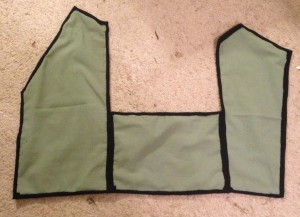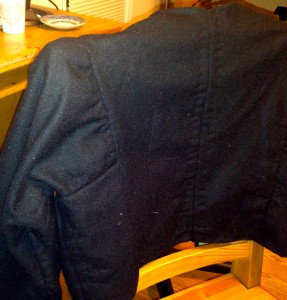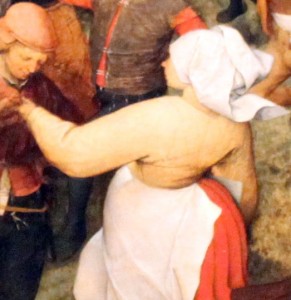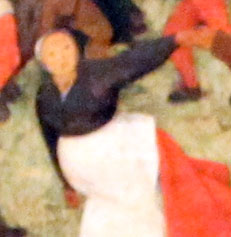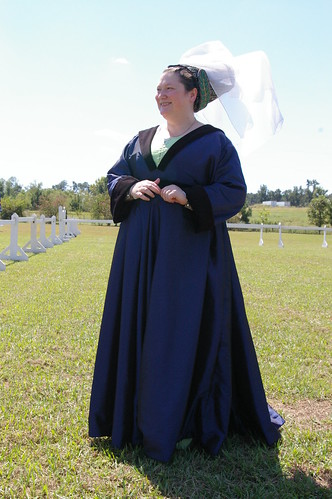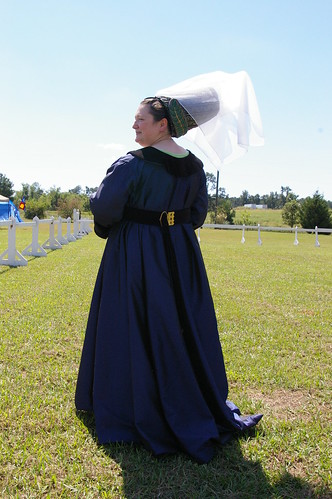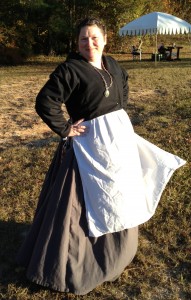
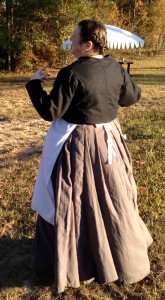 Here is the jacket in person, along with the new linen kirtle underneath and a very old apron. I still need to make a new coif to go with it. The ensemble seemed to wear well. I think I may take the side panels out, reattach the sleeves so they aren’t puckered at the shoulder, and reset and trim down the side panels at the bottom. That should be easy enough to do.
Here is the jacket in person, along with the new linen kirtle underneath and a very old apron. I still need to make a new coif to go with it. The ensemble seemed to wear well. I think I may take the side panels out, reattach the sleeves so they aren’t puckered at the shoulder, and reset and trim down the side panels at the bottom. That should be easy enough to do.
Category: Women
Brueghel Jacket: Construction
The basic concept seems to work fine, though the sleeve should probably have been much wider to match the painting. Still, it’s wide enough as it is. In fact, the sleeve was a bit wider than the arch of the armscye, so I opted to just ease it in rather than cut it down (since I’d already finished all the edges). Hopefully a little steam will smooth that out, and if it doesn’t I’m not too concerned about it. I also took it in about an inch and a half on each side with a tuck in the center of the side panels, to account for seam allowances that were in the pattern but didn’t happen in the final garment. I need to finish and install the other sleeve, and then it will be done, more or less. The plan is to do hooks and eyes up the front, but I may just pin it this weekend.
Brueghel Jacket: Source Images
I have plans to make myself some new clothes, but first I must make my lovely wife new clothes. I made her a Flemish peasant outfit once many years ago, and it seemed like time to try it again. I’d already done the combination of side-back laced kirtle and front laced overgown that everyone in the world has done, so I opted instead for a front laced kirtle and short jacket. There are a couple of examples in Brueghel’s Wedding Dance, conveniently showing similar jackets from the front and back:
I’ve always wanted to do something like this with a square sleeve head inserted into an arch-shaped armscye, so it should be interesting. I cut some rough rectangles that I thought would approximate the pattern pieces, then draped them on her while she was laced into the kirtle. I turned down the corners at the top to make the neckline, and took in the center back seam until it fit right, trying to keep all the pieces as simple as possible. The sleeve pattern is drafted from measurements.
I managed to cut all the pieces out of some black wool that used to be a cloak at some point, and cut the lining from some medium weight teal cotton that I’ve had for probably 15 years. I’m wrapping the wool around the edges of each piece and putting it all together by hand. Hopefully I’ll be able to get it done by this weekend when she needs to wear it…
Van der Weyden Gown: Finished
After Pennsic I got to work finishing up the gown, and had it done with plenty of time to spare for Adela’s elevation:
The gown turned out pretty well, though of course the thing that made the outfit was the hat! It was made by the lovely Madelena da Firenze (you can see construction details and a better close-up here).
Van der Weyden Gown: Progress and Belt
I put together the first draft of the Van der Weyden gown a couple months back, but it got put on the back burner in favor of my own Pennsic sewing. Now that the war is past, I’m getting busy on it again (since it needs to be done in three weeks!). I am indeed using the blue silk taffeta for the gown, backed with a couple of different medium-to-heavy plain fabrics. The first draft of the gown was a little skimpy at the hem, so today I ripped out the side seams and added some gores to provide plenty of yardage down below. The gown should be long enough to just brush the ground, with a bit of train in the back. Practicality is not a big consideration for this one. I had originally attached the sleeves by machine (which I was using for all the long seams of the gown), but I removed them and reinstalled them by hand, which gave an infinitely better fit. The sleeves are lined with thin white cotton, with an addition lining of black velveteen for the lower three-quarters of their length. The sleeves are long enough for a four or five inch turnback at the cuff. All I have left to do now is the collar, front seam, and hem.
Sadly, I don’t have any pictures of the gown yet, but I do have one of the belt. It’s made of the same black velveteen on both sides, with a core of heavy wool stitched to a layer of cotton/linen to hold it in place. The buckle I picked up at war from Thorthor’s Hammer, and the buckle plate is made from a piece of sheet brass. The belt is 2.5″ wide and about 65″ long. It will get a matching brass end soon.
Household Workshop Day
This weekend was the first chance I was able to get together with both my new student Philippa and my apprentice Serafina. We met up at Philippa’s house to work on various projects.
A couple weeks ago I helped Philippa drape a body block for herself. We used that to work out patterns for a kirtle and loose gown modeled after a portrait of Eleanora de Toledo. After a few iterations of drafting and test fitting, we arrived at a pretty good shape.
Serafina brought along a new pouch that she’s been working on, and made good progress on it. It’s shaping up to be very close to the period examples she’s working from.
After we finished sewing for the day, we went over a few dances that Philippa wanted to teach her students later this week. Despite having to imagine most of the other dancers in our sets, I think it went pretty well.
Van der Weyden Kirtle: Sleeves
I whipped up the sleeves tonight while watching TV. They’re nothing special, but I think they’ll do the job. I’ll try to get more pictures after I get the hem done.
Van der Weyden Gown: Planning
I’m not quite ready to start on it yet, but I have some ideas about the gown for this project. I think I want to do something like this:
I plan to make the gown from the blue silk taffeta that I used for my Bronzino suit, with black velvet for the collar and cuffs. I like this gown because it has nice unstructured pleats and wide sleeves that should make it easy to wear. I’ll need to back the taffeta with something heavier to give it some body, I’m sure.
As for the hat, I think I’ll try something more like this one:
Van der Weyden Kirtle: Skirt
Looking at the skirt in the painting, my first plan was to make a nice circle skirt with no pleats at the waistline. I cut a couple skirt length chunks of the linen, cut each of those up into four gores, French seamed it all together (on the machine!) and slapped it onto the bodice. I ended up with a few small pleats in the back, but I figured that would be fine.
It was not enough skirt. Nowhere near enough. Not much hem, didn’t fit well at the waist, and altogether terrible. I undid the waist seam and the center front seam (no French seam there, since it was two selvedge edges), cut another length of linen, divided into two mostly-rectangular trapezoids, and added it into the front of the skirt. I reattached it to the waist so the new section was pleated into the front half of the bodice, and the original gored part of the skirt all went in the back. I haven’t gotten a chance to try it on her yet, but it should fit just fine.
Can I justify the pleats? There are some pleats in the back of kirtles depicted by van der Weyden (like this one), and pleating all the way around the waist in this fairly contemporary painting by Hugo van der Goes. It’s not the ideal solution, but I think it’ll be sufficient.
Van der Weyden Kirtle: Bodice Finished
After adjusting the armscye, I attached the neckline facing:
I basted the facing in at the top and bottom (with the edge turned under), then used the bottom row of basting stitches as a guide to topstitch the facing from the front. I used a back stitch with two strands of cotton embroidery floss.
Next, I used the machine to attach the binding from the front and then hand sewed it down on the inside. After a pile of eyelets, the bodice was finished:
Here you can see the shoulder seams:
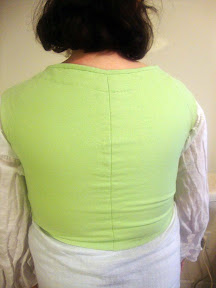

The neckline sits a little funny, especially in this spot, though it’s hard to see in this picture. I’m not going to mess with it until I get the sleeves and skirt on, and see if it works itself out.

